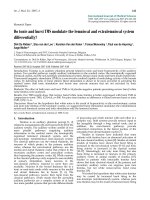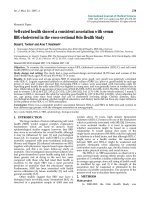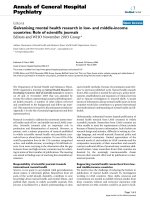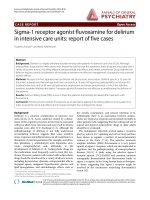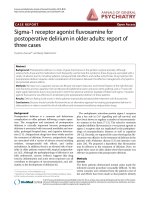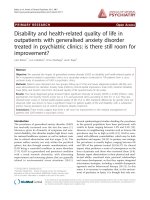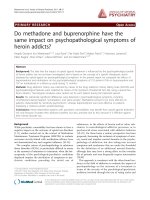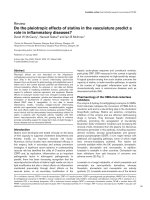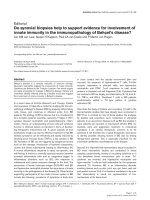Báo cáo y học: "Do electronic health records affect the patient-psychiatrist relationship? A before & after study of psychiatric outpatients" doc
Bạn đang xem bản rút gọn của tài liệu. Xem và tải ngay bản đầy đủ của tài liệu tại đây (267.49 KB, 9 trang )
RESEARC H ARTIC LE Open Access
Do electronic health records affect the
patient-psychiatrist relationship? A before & after
study of psychiatric outpatients
Randall F Stewart
1*
, Philip J Kroth
1
, Mark Schuyler
3
, Robert Bailey
2
Abstract
Background: A growing body of literature shows that patients accept the use of computers in clinical care.
Nonetheless, studies have shown that computers unequivocally change both verbal and non-verbal
communication style and increase patients’ concerns about the privacy of their records. We found no studies
which evaluated the use of Electronic Health Records (EHRs) specifically on psychiatric patient satisfaction, nor any
that took place exclusively in a psychiatric treatment setting. Due to the special reliance on communication for
psychiatric diagnosis and evaluation, and the emphasis on confidentiality of psychiatric records, the results of
previous studies may not apply equally to psychiatric patients.
Method: We examined the association between EHR use and changes to the patient-psychiatrist relationship. A
patient satisfaction survey was administered to psychiatric patient volunteers prior to and following
implementation of an EHR. All subjects were adult outpatients with chronic mental illness.
Results: Survey responses were grouped into categories of “Overall,”“Technical,”“Interpersonal,”“Communication &
Education,,”“Time,”“Confidentiality,”“Anxiety,” and “Computer Use.” Multiple, unpaired, two-tailed t-tests compa ring
pre- and post-implementation groups showed no significant differences (at the 0.05 level) to any questionnaire
category for all subjects combined or when subjects were stratified by primary diagnosis category.
Conclusions: While many barriers to the adoption of electronic health records do exist, concerns about disruption
to the patient-psychiatrist relationship need not be a prominent focus. Attention to communication style,
interpersonal manner, and computer proficiency may help maintain the quality of the patient-psychiatrist
relationship following EHR implementation.
Background
The current emphasis on the adoption and use of Elec-
tronic Health Records (EHRs) is well known. The Insti-
tute of Medicine advocated for EHR use as early as 2001
[1]. The Bush administration created the Office of the
National Coordinator for Health Information Technology
and set the goal of nationwide EHR implementation by
2014 [2,3]. The America n Recovery and Reinvestme nt
Act of 2009 will provide $20 billion in funding for health
information technology, while at the same time stipulat-
ing that physician practices which do not use a certified
EHR by 2014 may forfeit up to 3% of their Medicare
reimbursements [4]. Recent Medicare and Medicaid leg-
islation provides a 2% incentive for physicians to imple-
ment e-prescribing by 2009, while instituting a 2%
penalty for those that do not by 2012 [5].
In spite of the improving costs of initial investment,
barriers to EH R adoption remain [6]. Among these are
effects on eye contact, time with the patient, and clinical
workflow [7,8]; lack of interoperab ility between different
EHR systems [9,10]; the need for training and the effects
on time utilization [11]; culture changes, changes in the
distribution of power, and user resistance [12]; uncertain
or equivocal benefits [13,14]; and the introduction of
new errors and other types of unintended consequences
[15,16].
Patient satisfaction, however, does not seem to be a
barrier. Since the 1980s, numerous studi es have shown
* Correspondence:
1
Health Sciences Library & Informatics Center, MSC09 5100, 1 University of
New Mexico, Albuquerque, New Mexico 87131-0001, USA
Stewart et al. BMC Psychiatry 2010, 10:3
/>© 2010 Stewart et al; licensee BioMed Central Ltd. This is an Open Access article distr ibuted under the terms of the Creative Commons
Attribution Lic ense ( /by/2.0), w hich pe rmits unres tricted use, distribution, and reproduction in
any medium, provided the original work i s properly cited.
little change to overall patient satisfaction when physi-
cians use computers in a clinical setting [17-23].
Patients generally seem to accept the use of computers
in the delivery of t heir care. Some more recent studies
have indicated an increase in patient satisfaction when
EHRs are used [24,25]. Othe r studies have shown, how-
ever, that c ertain aspects of the patient-physician rela-
tionship are altered by computer use. Communication
style becomes less fluent [26-29] and concerns about
confidentiality of the health record increase [22,30-34].
Some early studies suggested that computer use may
lead to increases (or smaller decreases) in anxiety over
the course of an outpatient encounter [35-37] or that
physicians who use computers during encounters are
seen as “less ideal” than those who don’t [38].
Unfortunately, psychiatric patients may be dispropor-
tionately influenced by these changes. The patient-psy-
chiatrist relationship is arguably more reliant on
communication skills, confidentiality, and psychody-
namic interpretations than non-psychiatric specialties.
Makoul [39] found that electronic records may lead to
more “complete” documentation, but that there was a
non-significant decrease in the amount of “patient-cen-
tered” communication and exploration of psychosoci al
issues. Changes to communication pattern [40] or eye
contact [41] could conceivable lead practitioners to
overlook or misinterpret the verbal and non-verbal cues
which often lead to refined lines of inquiry. Similarly,
physical placement of computer equipment (such as in
corners, or around the perimeter of a room) could make
sustained observation of patient behavior difficult, or
lead to changes in the psychiatrist’s body language that
patients might misinterpreted as disinterest. The stigma
against mental illness may magnify patients’ concer ns
about confidentiality, leading to less open or less truth-
ful communication [33,40,42]. This could subsequently
alter screening for suicide or other high-risk events.
Because symptoms of anxiety are associated with diag-
noses of depression, bipolar disorder, schizophrenia,
substance use, and posttraumatic stress disorder,
changes in anxiety, brought about by EHR use, could
potentially alter the accurate evaluation of these disor-
ders. The “idealism ” study by Cruickshank [38], per-
formed in the United Kingdom in the early 1980s, is of
uncertain signi ficance today. It could represent discom-
fort with the emerging technology of the desktop com-
puter, or the desire f or a more traditional approach to
medicine. More recent studies, however, have likened
the computer to a “third party” in the examination
room, altering the physicians’ focus on the patient and
altering the quality of the therapeutic dyad [43-45].
We found no studies which looked exclusively at the
effect of EHR use on the r elationship between the
patient and his or her psychiatrist. This study
investigates the effect of EHR use among psychiatric
outpatients. A group of 161 psychiatric outpatients com-
pleted satisfaction surveys prior to EHR adoption and
another 141 completed surveys at least 4 months follow-
ing EHR adoption. The primary objective was to exam-
ine the correlation between EHR use and aspects of the
patient-psychiatric relationship. We hypothesized that
EHR use would decrease patient satisfaction scores
related to communication, confidentiality, and anxiety.
Methods
Study Design
We used a quasi-experimental, pre-test and post-test
design approved by the University of New Mexico
(UNM) Health Sciences Center Human Research Review
Committee (HRRC No. 04-365). The quasi-independent
variable was exposu re to paper charti ng (before an EHR
implementation) or electronic charting (after implemen-
tation). The dependent variable was the quality of the
patient-psychiatrist relationship as measured by a self-
administered, paper-based questionnaire. Patient pri-
mary diagnosis was also recorded as a covariate.
Instrument & Data Collection
Because of its ease of administration and its public avail-
ability, we chose the Rand Corporation’s previously vali-
dated Patient Satisfaction Questionnaire-18 (PSQ-18) as
a starting point in survey design [46]. The PSQ-18 cap-
tures seven dimensions of satisfaction, including “Gen-
eral Satisfaction,”“Technical Quality,”“Interpersonal
Manner,”“Communication,”“Financial Aspects,”“Time
Spent with Doctor,” and “ Accessibility and Conveni-
ence.” In order to control for acquiescence bias, the
PSQ-18 applies balanced keying, in which both posi-
tively and negatively worded questions are included.
Subjects record their responses on a five-point Likert
scale ranging from “Strongly Agree” (1) to “Strongly
Disagree” (5). During scoring, the scores for positively-
worded questions are reversed so that for all questions,
low scores consistently indicate low satisfaction and
high scores consistently indicate high satisfaction.
We included all of the original PSQ-18 questions
except for those in the “Financial Aspects” and “Accessi-
bility & Convenience” subscales. We removed those
questions since the literature review did not suggest that
EHR use would change patie nts’ attitudes towards these
factors. Where necessary to make questions psychiatric
specific, we replaced the word “ medical” with “psychia-
tric.”“Doctor” or “physician” was likewise replaced with
“psychiatrist.” This resulted in a draft of only 12 ques-
tions. Next, we added questions from an unpublished
and unvalidated survey which had been locally drafted
during study inception. This locally drafted survey
included all of the PSQ-18 subscales as well as three
additional subscales of “Anxiety,”“Computer use,” and
Stewart et al. BMC Psychiatry 2010, 10:3
/>Page 2 of 9
“Confidentiality.” The resulting composite draft, consist-
ing of both PSQ-18 and locally drafted questions,
included 49 questions.
Because questions on the locally drafted survey had been
rationally derived without statistical analysis, we solicited
feedback on survey design and understanding from a con-
venience sample of six inpatient volunteers from the
UNM Psychiatric Center inpatient wards. We used the
feedback to re-wo rd confusing questions and to rank the
questions by importance as perceived by the patients. In
the final survey, we included all of the PSQ-18 questions
(except for those in the “Financial Aspects” and “Accessi-
bility & Convenience” subscales), and retained only
enough of the highest-ranking local questions in order to
yield a one-page survey that included at least two ques-
tions in each subscale. This final, composite survey con -
tained 23 questions, 12 from the PSQ-18 and 11 from the
local survey. The questions and subscales of the final sur-
vey are shown in Table 1. We retained the original PSQ-
18 Likert scale and practice of balanced keying.
Setting & Subjects
Between November 2004 and December 2005, 161 pre-
implementation subjects were recruited. A total of 141
Post-implementation surveys were completed Between
December 2007 and December 2008. The 24-month
interim between collection periods resulted from unantici-
pated extensions to the EHR implementation date. It also
included a four-month acclimation period between full-
scale implementation and the beginning of post-imple-
mentation recruitment. This acclimation period was
intended to prevent the capture of transient results as phy-
sicians became more proficient with using the EHR.
All subjects were adult, ambulatory outpatients seen in
the University of New Mexico Psychiatric Center (UNM-
PC) Continuing Care Clinics. Approximately 2000
chronically mentally ill patients attend these clinics,
which are staffed by approximately 10 attending physi-
cians, 5 residents, t wo certified nurse practitioners, and
10 nurses. Approximately 20 to 40 patients per day are
treated for a wide range of psychiatric disorders, includ-
ing mood, psychotic, anxiety, and personality disorders.
Treatment focuses on medication manageme nt, although
short term psychotherapies are used for select patients.
Although case management is widely employed, t he vast
majority of patients are stabilized on medication and live
independently in the community. Dually-diagnosed
patients do attend these clinics, but most patients whose
primary diagnosis is substance use-related are seen at a
different UMN facility. Additionally, patients with
dementia or developmental disorders attend other clinics
and were therefore not sampled. Those that spoke no
English (estimated to be less than 1% of the clinic popu-
lation) were excluded from the study due to limited
bilingual resources. Patients who required psychiatric
hospital admission directly from their clinic appointment
were excluded from the sample population. During the
study period there were no significant changes to the
clinic routine other than EHR implementation.
Consent & Procedure
Potential subjects were approached as they checked out
from their outpatient appointments and asked if they
would like to participate in a research project inv estigat-
ing the effect of computer use on the patient-psychiatrist
relationship. Using a protocol based on order of arrival at
the checkout desk, we attempted to approach every
patient who checked out from clinic during the data col-
lection periods. If the subject indicated interest, they
were taken to an office or secluded are a of the waiting
room where the purpose, risks, and voluntary nature of
the study were fully explained to them. Those that con-
tinued to express an interest in participating gave written
consent. Each subject was permitted to complete only
one satisfaction survey in each study period.
We obtained the participants’ written consent for a
psychiatric record review and manually recorded their
most recent primary diagnosis from their psychiatric
record. For comparison of the pre- and post-implemen-
tation groups, we also collected race, age, and sex from
their hospital record.
Data Analysis
Target enrollment was 160 subjects per group. This
would allow unpair ed, two-tailed t -tests to detect a 5%
change in survey responses with a 5% chance of Type I
error, 20% chance of Type II error, and a standard
deviation of 0.8 (on a five-point Likert scale). Because
actual enrollment was less than our target, the smallest
significant effect size became 7% while maintaining the
same chance of Type I and Type II error.
The internal consistency reliability of the composite
survey was assessed using standardized Cronbach’scoef-
ficient alpha. Comparison between pre-implementation
and post-implementation groups was by chi-square tests
for categorical variables and by two-tailed, unpaired t-
tests for continuous variables. All t-tests used pooled var-
iance except for the “Overall” subscale of the Mood stra-
tum which used the Welch approximation to degrees of
freedom due to unequal variances. All statistical analyses
and graphics were prepare d using version 2.9.0 of the
open source and freely available R programming lan-
guage and environment for statistical computing [47].
Results
Comparison of Groups
A total of 161 pre-implementation and 141 post-imple-
mentation surveys were ini tially collected. After elimi-
nating redundant surveys, patient withdrawal, or unclear
inclusion criteria found on subsequent review, we were
Stewart et al. BMC Psychiatry 2010, 10:3
/>Page 3 of 9
left with 149 pre-implementation and 137 post-imple-
mentation surveys. During data analysis, infrequently
reported races or infrequently given primary diagnoses
were combined into “ Other” categories. Table 2 com-
pares demographic characteristics of the pre- and post-
implementation groups. The pre-implementation and
post-implementat ion groups were similar with respect
to age, race, sex, and primary diagnosis. Characteristics
of non-responders were not recorded.
Survey Internal Consistency Reliability
Table 3 shows the internal consistency reliability for
each of the subscales of the composite survey. Only one
of our subscales (Technical) met the 0.7 level that is
usually considered the minimum for desirable reliability.
The Communication & Education subscale scored lower
at 0.64, although this value is identical to that of the ori-
ginal PSQ-18 Communication subscale[46]. The three
locally generated subscales (Confidentiality, Anxiety, and
Computer Use) scored the lowest with standardized
alphas of 0.24, 0.59, and 0.38 respectively.
Electronic Health Record Associations
Figure 1 shows the change in average survey sub-scores
before and after EHR implementation. For all subjects,
and for subjects stratified by their primary diagnosis,
none of the changes reached statistical significance. A
post-hoc analysis of average responses for each question
separately (rather than grouped into subscales) also
showed no significant changes between pre- and post-
implementation groups. Raw, mean survey scores are
available from the primary author on request.
Table 1 Survey subscales and questions
Subscales & questions Original PSQ-18 subscale*
Overall:
The psychiatric care I have been receiving is just about perfect. General satisfaction
I am dissatisfied with some things about the psychiatric care I receive. General satisfaction
Technical:
I have some doubts about the ability of the psychiatrists who treat me. Technical quality
Sometimes psychiatrists make me wonder if their diagnosis is correct. Technical quality
My psychiatrist could be a lot better. local
I think my psychiatrist’s office has everything needed to provide complete psychiatric care. Technical quality
When I go for psychiatric care, they are careful to check everything when treating and examining me. Technical quality
Interpersonal:
Psychiatrists act too businesslike and impersonal toward me. Interpersonal manner
I wish that I had a different psychiatrist. local
My psychiatrist treats me in a very friendly and courteous manner. Interpersonal manner
Communication & Education:
Psychiatrists sometimes ignore what I tell them. Communication
My psychiatrist understands what I tell him or her. local
The psychiatrist answers all of my questions. local
My psychiatrist is too quiet. local
Psychiatrists are good about explaining the reasons for tests. Communication
Time:
Those who provide my psychiatric care sometimes hurry too much when they treat me. Time spent with doctor
Psychiatrists usually spend plenty of time with me. Time spent with doctor
Confidentiality:
My psychiatric record is kept safe. local
I worry about who sees my psychiatric record. local
Anxiety:
I worry about the future. local
I worry about my psychiatric care. local
Computer Use:
The computer gets in the way of the psychiatrist. local
I am comfortable with the computer in my psychiatrist’s office. local
*In the “Original PSQ-18 subscale” column, “local” indicates the question was based on an unpublished survey that had been drafted by the Principle Investigator
during study inception. Otherwise, the question was based on the PSQ-18 and this column shows its PSQ-18 subscale. The Confidentiality, Anxiety, and
Computer Use subscales contain locally drafted questions only and are not part of the original PSQ-18 scoring system. PSQ-18 questions belonging to the
“Financial Aspects” and “Accessibility & Convenience” subscales were not used.
Stewart et al. BMC Psychiatry 2010, 10:3
/>Page 4 of 9
Discussion
Although the adoption of Electronic Health Records in
the United States has proceeded cautiously, in today’s
technol ogically-dependent environment the trend is not
likely to be reversed. Instead, emphasis may best be
placed on the design of efficient EHR systems [48],
determinatio n of best practices for their use [49], atten-
tion to communication skills (regardless of the charting
modality) [50], and more rigorous collection of data to
assess the true impact of EHR use on quality of care,
costs, efficiency, and patient views [24].
This study is the first we are aware of that a ttempted
to assess the impact of EHR use on the quality of the
patient-psychiatrist relationship in a behavioral health
venue. Consistent with several decades of research in
the non-psychiatric realm, we found no c hange in
satisfaction scores among adult, psychiatric patients
when an EHR was used during outpatient encounters
instead of paper charting. Our results should lessen the
concerns of behavioral health provider s and clinic man-
agers who are hesitant to adopt EHRs because of con-
cerns over potentially negative reactions from their
patients. Contrary to our hypotheses and some prior
studies, we found no change in patient satisfaction in
the Communication & Education, Confidential ity, Anxi-
ety, or any other satisfaction subscales.
Because our samples were powered for a 7% change in
satisfaction, Type II error is not likely to explain the
lack of significance. Instead, the lack of findings may
represent a truly negligible impact of EHR use on the
patient-psychiatrist relationship, or it may be due to
study limitations.
Limitations
Interpretation of our results should be tempered in light
of its limitations. First, all of our measures were surro-
gate estimates. We did not attempt to directly measure
actual changes in communication patterns, anxiety, or
changes in behavior (either on the part of the patient or
the psychiatrist). We also did not measure changes in
actual patient outcomes.
Second, our survey was not validated. Though it was
based on a valid instrument, the changes we made to it
resulted in substant ially lower internal consistency relia-
bility than the PSQ-18. As well, the PSQ-18 was initially
validated in a population that was not exclusively psy-
chiatric and its native validity might not apply as well to
the psychiatric population. The ad-hoc analysis, in
which the pre- and post-implementation responses to
individual questions (as opposed to subscales) were
Table 2 Comparison of groups
Pre-implementation Post-implementation c
2
(t for age) df p
Number of respondents 149 137
Average age (years) 49.9 47.6 t = 1.823 284 0.07
% female (n) 50% (75) 55% (75) 0.747 1 0.39
Race*: 2.654 2 0.27
Caucasian 91 (61%) 74 (54%)
Hispanic 39 (26%) 48 (35%)
Other 19 (13%) 15 (11%)
Primary diagnosis**: 0.555 2 0.78
Mood 83 (55%) 80 (59%)
Psychotic 48 (32%) 43 (31%)
Other 19 (13%) 14 (10%)
* Racial categories of “Black or African American” (9 pre-implementation; 7 post-implementation), “American Indian or Alaskan Native” (0 pre-implementation; 2
post-implementation); and “Other” (9 pre-implementation; 6 post-implementation) were combined into one “Other” category for statistical analysis.
** Primary diagnosis categories of “Anxiety” (16 pre-implementation; 8 post-implementation), “Substance use” (0 pre-implementation; 3 post-implementation),
and “Other” (3 pre-implementation; 3 post-implementation) were combined into one “Other” category for statistical analysis.
Table 3 Internal consistency reliability for composite sur-
vey subscales
Composite
survey
subscale
Standardized
alpha
Original
PSQ-18
subscale
Original
PSQ-18 alpha
Overall 0.58 General 0.75
Technical 0.77 Technical quality 0.74
Interpersonal 0.57 Interpersonal
manner
0.66
Communication
& Education
0.64 Communication 0.64
Time 0.67 Time Spent with
Doctor
0.77
Confidentiality 0.24
Anxiety 0.59
Computer Use 0.38
Stewart et al. BMC Psychiatry 2010, 10:3
/>Page 5 of 9
All subjects
Overall
Technical
Interpersonal
Communication & education
Time
Confidentiality
Anxiety
Computer use
0.422
0.687
0.151
0.210
-0.567
0.746
-0.266
-1.520
284
284
284
284
284
282
283
282
0.67
0.49
0.88
0.83
0.57
0.46
0.79
0.13
0.057
0.074
0.014
0.019
-0.079
0.092
-0.039
-0.173
-0.207-0.320
-0.138-0.286
-0.172-0.201
-0.161-0.199
-0.355-0.196
-0.150-0.335
-0.327-0.249
-0.396-0.051
Computer use -1.066 89 0.29
Psychotic primary diagnosis
Overall
Technical
Interpersonal
Communication & education
Time
Confidentiality
Anxiety
0.528
1.117
0.495
-0.359
0.244
1.895
-1.071
89
89
89
89
89
89
88
0.60
0.27
0.62
0.72
0.81
0.06
0.29
-0.225
0.119
0.190
0.072
-0.058
0.056
0.416
-0.273
-0.645-0.195
-0.330-0.569
-0.148-0.528
-0.217-0.361
-0.382-0.265
-0.403-0.517
-0.020-0.853
-0.779-0.223
Mood primary diagnosis
Overall
Technical
Interpersonal
Communication & education
Time
Confidentiality
Anxiety
Computer use
-0.129
-0.082
0.022
0.658
-0.964
-0.705
0.397
-1.462
160
160
160
160
160
158
160
158
0.99
0.94
0.98
0.51
0.34
0.48
0.69
0.15
-0.024
-0.012
0.003
0.081
-0.179
-0.113
0.075
-0.209
-0.394-0.346
-0.311-0.287
-0.256-0.261
-0.162-0.324
-0.544-0.187
-0.428-0.203
-0.298-0.447
-0.491-0.073
Computer use -0.531-0.862 0.485 31
0.63
Other primary diagnosis
Overall
Technical
Interpersonal
Communication & education
Time
Confidentiality
Anxiety
0.787*
0.602
-0.079
-0.225
0.213
0.887
0.297
19.18
31
31
31
31
31
31
0.44
0.55
0.94
0.82
0.83
0.38
0.77
0.165
0.297
0.194
-0.025
-0.053
0.107
0.323
0.150
-0.493-1.087
-0.463-0.850
-0.669-0.619
-0.529-0.423
-0.918-1.132
-0.420-1.067
-0.882-1.183
Mean
difference 95% CI t*
df p
-0.5
0
0.5
1
Mean difference
Figure 1 Change in satisfaction sub-scores. *All t-tests were based on pooled variance except for the Overall subscale of the Mood stratum
which used the Welch approximation to degrees of freedom due to unequal variance.
Stewart et al. BMC Psychiatry 2010, 10:3
/>Page 6 of 9
compared, was performed to address this deficiency.
Although there is u ncertainty in the exact quality being
measured by each question, we do know that there were
no statistically significant changes to the subjects’ ratings
of each question. We retained the concept of subscales
in our reporting for their face validity and as a way of
summarizing data. In order to avoid invalid compari son
with the original PSQ-18 subscales, the labels given to
our composite subscales were slightly altered from those
of the PSQ-18.
The characteristics of any particular EHR system, or
the way individual providers use the EHR, can clearly
affect patient-physician interaction [51]. We intention-
ally did not control for the EHR usage patterns of indi-
vidual providers in order to enhance the sense of
patient-provider privacy a nd to keep the research pro-
ject strictly separate from any expectations regarding
EHR use. Instead, we relied on a large sample size and
very low provider turnover to enhance the probability
that each provider would be equally represented in the
pre-implementation and post-implementation groups.
Fourth, consistent with much survey research of a
voluntary nature, our sampling strategy ma y have biased
our samples towards subj ects who were more likely to
participate in the project because of high satisfaction.
Finally, our use of primary diagnosis offers only a
coarse description of t he patient pathology and types of
personality characteristics that could affect a patient’s
reactions to EHR use. Many psychiatric diagnoses are
co-morbid, particularly mood, personality, and anxiety
disorders, and the disorder considered primary on any
particular visit may not remain constant. This may have
increased the heterogeneity of patient characteristics
within each diagnosis strata, while also increasing the
homogeneity between strata. Similarly, we did not differ-
entiate between patients with and without personality
disorders. Because Axis II disorders are rarely used as
the primary diagnoses, we did not attempt to stratify by
Axis II pathology. Also, in order to maintain sufficient
numbers of subjects in each diagnostic stratum, we
grouped diagnoses by major diagnostic category (e.g.
“mood disorder”) rather than actual primary diagnosis
(e.g., “ Major Depressive Disorder, recurrent, severe,
without psychotic features”). This resulted in only three
broad diagnostic strata of “Mood,”“Psychotic,” and
“Other” disorders.
Conclusion
Consistent with previously published studies on EHR
use and patient satisfaction, this study suggests that the
use of an Electronic Health Record does not change the
overall quality of the patient-psychiatrist relationship.
Patient satisfaction has been shown to affect patient
compliance [52,53], treatment outcomes [54,55],
malpractice suits [56,57], a nd the ability to remember
instructions [58,59]. Communication skills have consis-
tently shown to affect patient satisfaction [60-62].
Therefore, factors which change communication pat-
terns might also be expected to affect patient outcomes.
Psychiatr ists and psychiatric patients, who are especially
reliant on and sensitive to communication skills, are
understandably concerned about the potential impact of
EHR use on quality of care provided. This study
increases the confidence with which we can extend
prior EHR satisfaction studies into the psychiatric rea lm.
While other barriers to EHR adoption do exist, concerns
about excessive disruption to the patient-psychiatrist
relationship need not be one of them.
Acknowledgements
This study was supported by the National Library of Medicine Grant No. 1
F37 LM008747. Statistical consultation was funded through DHHS-NIH-NCRR
GCRC Grant No. 5M01-RR00997 and provided by Ron Schrader, Ph.D., UNM
Professor of Math and Statistics.
Author details
1
Health Sciences Library & Informatics Center, MSC09 5100, 1 University of
New Mexico, Albuquerque, New Mexico 87131-0001, USA.
2
Department of
Psychiatry, MSC09 5030e, 1 University of New Mexico, Albuquerque, NM
87131, USA.
3
Department of Internal Medicine, MSC10 5550, 1 University of
New Mexico, Albuquerque, NM 87131, USA.
Authors’ contributions
The primary author (RFS) is responsible for the study concept, initial design,
data collection, data analysis, and initial manuscript preparation. MS
contributed to study design aspects involving human research, statistical
analysis, and data collection methods. RB and PJK participated in psychiatric
and biomedical informatics aspects of the study design respectively. All
authors read and approved the final manuscript.
Authors’ Information
RFS is an assistant professor in the Department of Biomedical Informatics
Research, Training and Scholarship. MS is a professor of Internal Medicine
and the Associate Program Director of the UNM General Clinical Research
Center Scholars’ Program. RB is a Professor of Psychiatry and the Associate
Dean for Clinical Affairs of the UNM School of Medicine. PJK is an Assistant
Professor and the Director of Biomedical Informati cs Research, Training and
Scholarship in the UNM Health Sciences Library & Informatics Center. PJK
also has an appointment in the Department of Internal Medicine.
Competing interests
None of the authors report any conflicts of interest, competing interests, or
financial disclosures. The National Library of Medicine sponsored this study
as part of an Individual Biomedical Informatics Fellowship Grant. The sponsor
approved the study design as appropriate for the educational goals of the
primary author’s (RFS) fellowship, but played no role in the conduct of the
study, data collection, data analysis, data interpretation, or preparation of the
manuscript.
Received: 12 June 2009
Accepted: 8 January 2010 Published: 8 January 2010
References
1. Institute of Medicine; Committee on Quality of Health Care in America: To
Err is Human: Building a Safer Health System Washington, D.C.: National
Academies Press 2000.
2. Steinbrook R: Health care and the American Recovery and Reinvestment
Act. N Engl J Med 2009, 360(11):1057-60.
3. Heath highway: Nature 2009, 458(7236):259-60.
Stewart et al. BMC Psychiatry 2010, 10:3
/>Page 7 of 9
4. Ledue C: Physicians to receive incentives for EHR use. Healthcare Finance
News 2009 />incentives-ehr-use.
5. Ford EW, Menachemi N, Peterson LT, Huerta TR: Resistance is futile: but it
is slowing the pace of EHR adoption nonetheless. J Am Med Inform Assoc
2009, 16:274-81.
6. Ash JS, Bates DW: Factors and forces affecting EHR system adoption:
report of a 2004 ACMI discussion. J Am Med Inform Assoc 2005, 12:8-12.
7. Linder JA, Schnipper JL, Tsurikova R, Melnikas AJ, Volk LA, Middleton B:
Barriers to electronic health record use during patient visits. AMIA Annu
Symp Proc 2006, 499-503.
8. Chaudhry B, Wang J, Wu S, Maglione M, Mojica W, Roth E, Morton SC,
Shekelle PG: Systematic review: impact of health information technology
on quality, efficiency, and costs of medical care. Ann Intern Med 2006,
144:E12-E22.
9. Baron RJ, Fabens EL, Schiffman M, Wolf E: Electronic health records: just
around the corner? or over the cliff?. Ann Intern Med 2005, 143(3):222-6.
10. Jaspers MW, Knaup P, Schmidt D: The computerized patient record:
where do we stand. Yearb Med Inform 2006, 29-39.
11. Poissant L, Pereira J, Tamblyn R, Kawasumi Y: The impact of electronic
health records on time efficiency of physicians and nurses: a systematic
review. J Am Med Inform Assoc 2005, 12:505-16.
12. Jeijden Van Der MJ, Tange HJ, Troost J, Hasman A: Determinants of
success of inpatient clinical information systems: a literature review. J
Am Med Inform Assoc 2003, 10(3):235-43.
13. Kaushal R, Shojania KG, Bates DW: Effects of computerized physician order
entry and clinical decision support systems on medication safety: s
systematic review. Arch Intern Med 2003, 163(12):1409-16.
14. Hunt DL, Haynes RB, Hanna SE, Smith K: Effects of computer-based clinical
decision support system on physician performance and patient
outcomes: a systemic review. JAMA 1998, 280(15):1339-46.
15. Ash JS, Berg M, Coiera E: Some unintended consequences of information
technology in health care: the nature of patient care information
system-related errors. J Am Med Inform Assoc 2004, 11:104-12.
16. Campbell EM, Sittig DF, Ash JS, Guappone KP, Dykstr RH: Types of
unintended consequences related to computerized provider order entry.
J Am Med Inform Assoc 2006, 13:547-56.
17. Aydin CE, Rosen PN, Jewell SM, Fellitti VJ: Computers in the examining
room: the patient’s perspective. Proc Annu Symp Comput Appl Med Care
1995, 824-8.
18. Koide D, Asonuma M, Naito K, Igawa S, Shimizu S: Evaluation of electronic
health records from viewpoint of patients. Stud Health Technol Inform
2006, 122
:304-8.
19. Ridsdale L, Hudd S: Computers in the consultation: the patient’s view. Br
J Gen Pract 1994, 44:367-9.
20. Garrison GM, Bernard ME, Rasmussen NH: 21
st
-century health care: the
effect of computer use by physicians on patient satisfaction at a family
medicine clinic. Fam Med 2002, 34(5):362-8.
21. Penrod LE, Gadd CS: Attitudes of academic-based and community-based
physicians regarding EMR use during outpatient encounters. Proc AMIA
Symp 2001, 528-32.
22. Ornstein S, Bearden A: Patient perspectives on computer-based medical
records. J Fam Pract 1994, 38(6):606-10.
23. Solomon GL, Dechter M: Are patients pleased with computer use in the
examination room?. J Fam Pract 1995, 41:241-4.
24. Delpierre C, Cuzin L, Fillaux J, Alvarez M, Massip P, Lang T: A systematic
review of computer-based patient record systems and quality of care:
more randomized clinical trials or a broader approach?. Int J Qual Health
Care 2004, 16(5):407-16.
25. Johnson KB, Serwint JR, Fagan LA, Thompson RE: Computer-based
documentation: effects on parent-provider communication during
pediatric health maintenance encounters. Pediatrics 2008, 122(3):590-8.
26. Greatbatch D, Heath C, Campion P, Luff P: How do desk-top computers
affect the doctor-patient interaction?. Fam Pract 1995, 12:32-6.
27. Warshawsky SS, Pliskin JS, Urkin J, Cohen N, Sharon A, Binstok M,
Margolis CZ: Physician use of a computerized medical record system
during the patient encounter: a descriptive study. Comput Methods
Programs Biomed 1994, 43(3-4):269-73.
28. Sullivan F, Mitchell E: Has general practitioner computing made a
difference to patient care? A systematic review of published reports.
BMJ 1995, 311:848-52.
29. Brownbridge G, Lilford RJ, Tindale-Biscoe S: Use of a computer to take
booking histories in a hospital antenatal clinic. Acceptability to
midwives and patients and effects on the midwife-patient interaction.
Med Care 1988, 26(5):474-87.
30. Churgin PG: Computerized patient records: the patients’ response. HMO
Pract 1995, 9(4):182-5.
31. Gadd CS, Penrod LE: Dichotomy between physicians’ and patients’
attitudes regarding EMR use during outpatient encounters. Proc AMIA
Symp 2000, 275-9.
32. Rethans J, Hoppener P, Wolfs G, Diederiks J: Do personal computers make
doctors less personal?. Br Med J 1988, 296:1446-8.
33. Mitchell E, Sullivan F: A descriptive feast but an evaluative famine:
systematic review of published articles on primary care computing
during 1980-97. BMJ 2001,
322:279-82.
34. Carman D, Britten N: Confidentiality of medical records: the patient’s
perspective. Br J Gen Pract 1995, 45(398):485-8.
35. Brownbridge G, Herzmark GA, Wall TD: Patient reactions to doctors’
computer use in general practice consultations. Soc Sci Med 1985,
20(1):47-52.
36. Cruickshank PJ: Patient stress and the computer in the consulting room.
Soc Sci Med 1982, 16:1371-6.
37. Pringle M, Robins S, Brown G: Computers in the surgery the patient’s
view. Br Med J (Clin Res Ed) 1984, 288:289-91.
38. Cruickshank PJ: Patient rating of doctors using computers. Soc Sci Med
1985, 21(6):615-22.
39. Makoul G, Curry RH, Tang PC: The use of electronic medical records:
communication patterns in outpatient encounters. J Am Med Inform
Assoc 2001, 8:610-5.
40. McGrath JM, Arar NH, Pugh JA: The influence of electronic medical record
usage on nonverbal communication in the medical interview. Health
Informatics J 2007, 13:105-18.
41. Duggan AP, Parrott RL: Physicians’ nonverbal rapport building and
patients’ talk about the subjective component of illness. Hum Commun
Res 2001, 27:299-311.
42. Annas GJ: The Rights of Patients: The ACLU Guide to Patient Rights
Carbondale, Ill.: Southern Illinois University Press, 2 1989.
43. Margalit RS, Roter D, Dunevant MA, Larson S, Reis S: Electronic medical
record use and physician-patient communication: an observational
study of Isreali primary care encounters. Patient Educ Couns 2006,
61(1):134-41.
44. Als AB: The desk-top computer as a magic box: patterns of behavior
connected with the desk-top computer: GPs’ and patients’ perceptions.
Fam Pract 1997, 14:17-23.
45. Hsu J, Huang J, Fung V, Robertson N, Jimison H, Frankel R: Health
information technology and physician-patient interactions: impact of
computers on communication during outpatient primary care visits. J
Am Med Inform Assoc 2005, 12:474-80.
46. Marshall GN, Hays RD: The Patient Satisfaction Questionnaire Short-Form
(PSQ-18)
Santa Monica, Ca.: Rand 1994.
47. R Development Core Team: R: A Language and Environment for Statistical
Computing Vienna, Austria: R Foundation for Statistical Computing 2009.
48. Häyrinen K, Saranto K, Nykänen P: Definition, structure, content, use and
impacts of electronic health records: a review of the research literature.
Int J Med Infom 2008, 77(5):291-304.
49. Ventres W, Kooienga S, Marlin R: EHRs in the exam room: tips on patient-
centered care. Fam Pract Manag 2006, 13(3):45-7.
50. Frankel R, Altschuler A, George S, Kinsman J, Jimison H, Robertson NR,
Hsu J: Effects of exam-room computing on clinician-patient
communication: a longitudinal qualitative study. J Gen Intern Med 2005,
20:677-82.
51. Rouf E, Whittle J, Lu N, Schwartz M: Computers in the exam room:
differences in physician-patient interaction may be due to physician
experience. J Gen Intern Med 2007, 22(1):43-8.
52. Starfield B: Stability and change: another view. Am J Public Health 1981,
71(3):301-2.
53. Wolf MH, Putnam SM, James SA, Stiles WB: The Medical Interview
Satisfaction Scale: development of a scale to measure patient
perceptions of physician behavior. J Behav Med 1978, 1(4):391-401.
54. Ries R, Jaffe C, Comtois K, Kitchell M: Treatment satisfaction compared
with outcome in severe dual disorders. Community Ment Health J 1999,
35(3):213-21.
Stewart et al. BMC Psychiatry 2010, 10:3
/>Page 8 of 9
55. Priebe S, Gruyters T: Patients’ assessment of treatment predicting
outcome. Schizophr Bull 1995, 21(1):87-94.
56. Levinson W, Roter DL, Mullooly JP, Dull VT, Frankel RM: Physician-patient
communication. The relationship with malpractice claims among
primary care physicians and surgeons. JAMA 1997, 277(7):553-9.
57. Beckman HB, Markakis KM, Suchman AL, Frankel RM: The doctor-patient
relationship and malpractice. Lessons from plaintiff depositions. Arch
Intern Med 1994, 154(12):1365-70.
58. Ley P, Spelman MS: Communications in an out-patient setting. Br J Soc
Clin Psychol 1965, 4(2):114-6.
59. Ware JE, Davies AR: Behavioural consequences of consumer
dissatisfaction with medical care. Eval Program Plann 1983, 6:291-7.
60. White J, Levinson W, Roter D: “Oh, by the way ": the closing moments
of the medical visit. J Gen Intern Med 1994, 9(1):24-8.
61. Hall JA, Dornan MC: Meta-analysis of satisfaction with medical care:
description of research domain and analysis of overall satisfaction levels.
Soc Sci Med 1988, 27(6):637-44.
62. Woolley FR, Kane RL, Hughes CC, Wright DD: The effects of doctor-patient
communication on satisfaction and outcome of care. Soc Sci Med 1978,
12(2A):123-8.
Pre-publication history
The pre-publication history for this paper can be accessed here:http://www.
biomedcentral.com/1471-244X/10/3/prepub
doi:10.1186/1471-244X-10-3
Cite this article as: Stewart et al.: Do electronic health records affect the
patient-psychiatrist relationship? A before & after study of psychiatric
outpatients. BMC Psychiatry 2010 10:3.
Publish with BioMed Central and every
scientist can read your work free of charge
"BioMed Central will be the most significant development for
disseminating the results of biomedical research in our lifetime."
Sir Paul Nurse, Cancer Research UK
Your research papers will be:
available free of charge to the entire biomedical community
peer reviewed and published immediately upon acceptance
cited in PubMed and archived on PubMed Central
yours — you keep the copyright
Submit your manuscript here:
/>BioMedcentral
Stewart et al. BMC Psychiatry 2010, 10:3
/>Page 9 of 9

